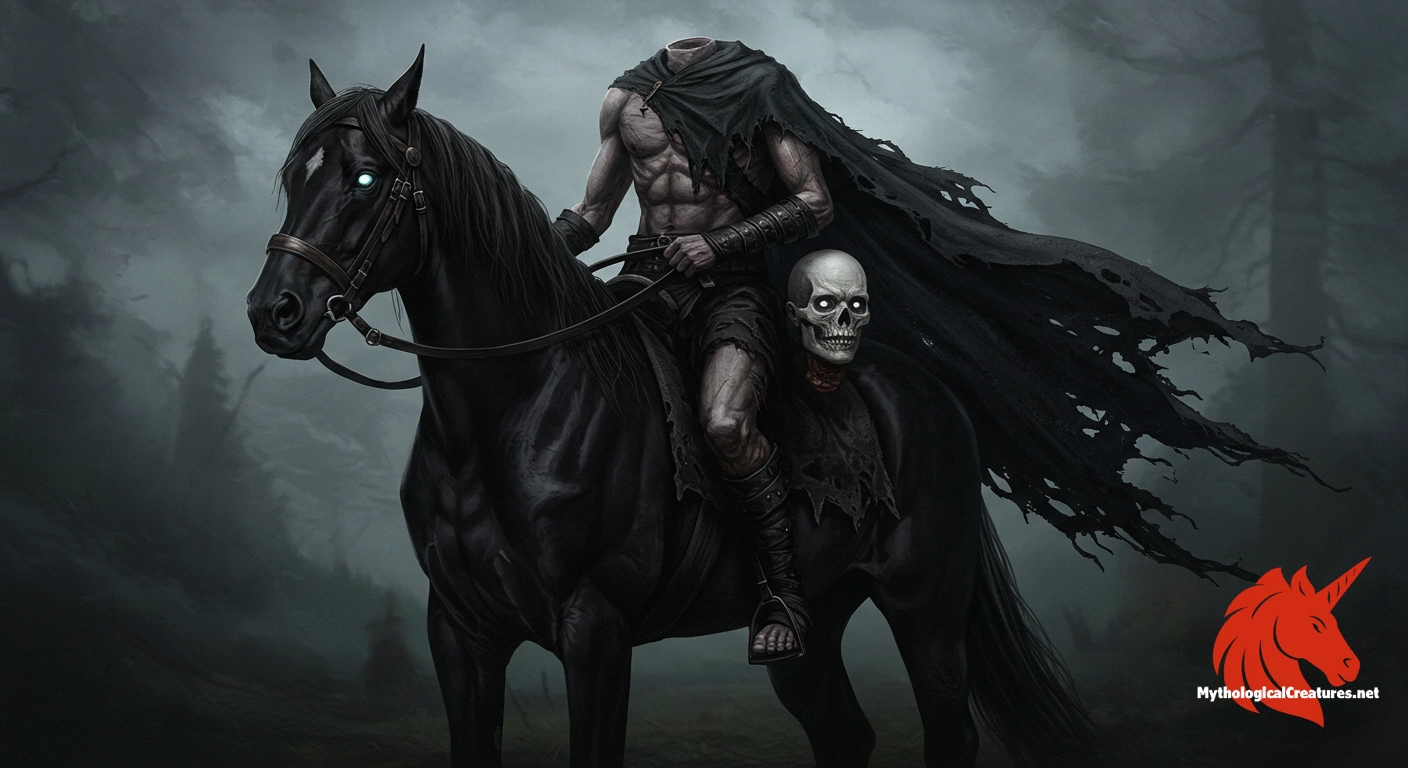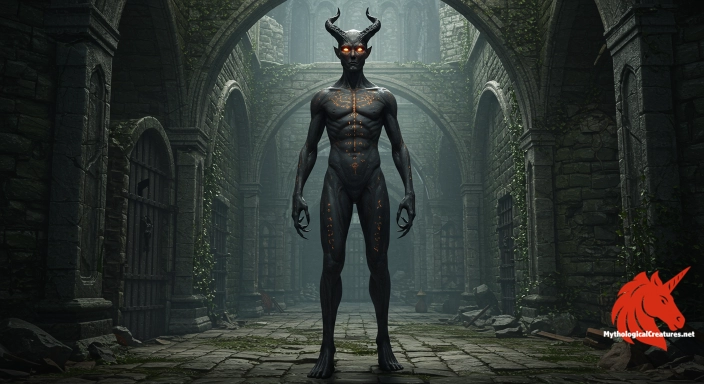Dullahan: The Dullahan is a headless rider from Irish folklore, often depicted riding a black horse while carrying its own head.

Dullahan
Dullahan - Represents the inevitability of death and the supernatural personification of mortality
Origins & First Encounters
The Dullahan emerges as one of the most enigmatic figures within Irish myth, a spectral embodiment of death that has captivated imaginations for centuries.
Its story appears to have developed in the shadowy corners of folklore, where the interplay between life and the hereafter is rife with mystery and portent.
Legends recount a headless rider, whose very existence is a paradox, straddling the realms of life and death with uncanny precision.
This creature is often portrayed as a solitary, foreboding entity, whose presence signals an imminent encounter with mortality.
Although originally rooted in ancient Irish traditions, the Dullahan’s true origins are subject to debate, with some scholars pondering whether it was a product of local myth or an import later adapted to suit Irish sensibilities.
The spectral rider’s image, couched in themes of inevitability and the macabre, has transformed with the passage of time yet remains a powerful symbol in Irish culture.
Over the years, its narrative has been shaped by oral tradition, local lore, and the occasional literary embellishment, ensuring its place as a haunting reminder of life’s impermanence.
Its enduring allure lies in the blend of terror and fascination it inspires, making the Dullahan an iconic figure in the broader landscape of myth and legend.
Source Texts & Tale Variants
Accounts of the Dullahan in primary sources are notably sparse, with its earliest mentions woven into the fabric of oral tradition rather than codified texts.
While the creature does not feature prominently on mainstream folklore repositories, its eerie reputation has been preserved in local narratives passed down through generations.
Some early manuscripts and anecdotal records hint at fleeting encounters with a headless rider, elevating it to a mythic status in various rural communities.
Despite the limited archival material, the motif of the Dullahan has been amplified by later literary works that sought to capture the eerie essence of Irish supernatural lore.
Variations of its narrative are found in collections of Gaelic tales, where the creature is sometimes depicted as a harbinger of doom or a collector of souls.
Other sources offer transformative interpretations, such as presenting the Dullahan as a spectral coachman rather than solely a lone rider.
This multiplicity of versions, although fragmentary, underscores the adaptability of the myth across different regions and eras.
The cumulative effect of these varied accounts has cemented the Dullahan in cultural consciousness, even as its precise historical roots remain elusive.
Form & Powers
The Dullahan is primarily distinguished by its headless appearance, a feature that immediately separates it from ordinary representations of the mortal body.
It is customarily illustrated as riding a jet-black horse, the animal itself exuding an aura of unearthly power and darkness.
In many portrayals, the creature carries its own severed head under one arm, an unsettling sight that compounds its fearsome reputation.
Descriptions of the head vary, with some legends attributing to it a visage that shifts between expressions of rage and sorrow.
Glowing eyes and a pallid complexion often accompany the head, emphasising the supernatural qualities of this enigmatic being.
The rider’s attire is commonly depicted as a tattered cloak or dark overcoat, underscoring the contrast between human form and spectral anomaly.
There are also accounts that hint at the use of a bone or spine whip, a chilling accessory that reinforces the Dullahan’s associations with death.
Throughout various narratives, the creature is sometimes described as having a commanding, almost larger-than-life stature, reinforcing its role as a portent of fatal destiny.
Regional Faces
Regional interpretations of the Dullahan vary significantly across Ireland, each adapting the creature to reflect local cultural nuances and superstitions.
In some rural areas, the Dullahan is seen as a solitary figure haunting lonely roads and desolate crossroads, its appearance a dire warning to the unwary traveller.
In highland regions, local lore often imbues the Dullahan with a connection to ancient ancestral spirits, merging the myth with the region’s storied past.
Variations in its narrative sometimes include additional supernatural embellishments, such as mysterious objects or talismans unique to specific counties.
Some communities have interwoven the legend with local historical events, portraying the Dullahan as an echo of past tragedies or battles.
In contrast, urban adaptations of the myth adjust its setting to modern cityscapes while retaining its core attributes of forewarning and doom.
This regional adaptation highlights the flexibility of the myth, as storytellers tailor details to heighten the sense of inevitable fate in their own backdrops.
Even as popular media revives the story in contemporary settings, the local spirit of the Dullahan endures, manifesting in diverse forms that resonate with regional sensibilities.
Cultural Parallels
The myth of the Dullahan finds cultural parallels in many parts of the world, resonating with universal themes of death and the supernatural.
A close comparative figure is the Headless Horseman of American folklore, whose tale was popularised in literary works and has become a staple of modern ghost stories.
Both entities serve as harbingers of death, prowling in the darkness to signal the passage from life to the unknown.
Across Europe, similar headless apparitions have been recounted, often tied to the legends of the Wild Hunt and other spectral cavalcades that merge the mortal with the supernatural.
These figures, although varying in detail, share a common motif: the severed head as a symbol of the transitional boundary between life and death.
Such parallels underscore the ability of diverse cultures to transform shared existential fears into distinct, yet recognisable, mythological figures.
This cross-cultural tapestry of headless riders also reflects a broader human preoccupation with the mysteries of mortality and the afterlife.
In comparative studies, the Dullahan stands out as a particularly vivid manifestation of these enduring fears, illustrating how mythic imagery transcends geographic and cultural boundaries.
Legacy & Modern Evolution
The evolution of the Dullahan myth illustrates a remarkable journey from its obscure folkloric roots to a contemporary icon in horror and popular culture.
Originally encoded in whispered rural tales and local superstitions, its haunting image was gradually adapted and expanded upon through literature and the visual arts in the Victorian era.
This period saw the creature transformed into a symbol not only of impending death but also of the mysterious forces that govern fate.
In more recent times, the Dullahan has enjoyed a resurgence through film, television, and graphic novels, where its spectral allure captivates new audiences.
Modern reinterpretations often play with the traditional characteristics, sometimes reimagining the figure as both an ominous omen and a tragic anti-hero caught between worlds.
These adaptations have introduced the myth to a global audience, ensuring that its eerie presence remains relevant in a rapidly changing cultural landscape.
Festivals, art exhibitions, and even theme-based events have embraced the legacy of the headless rider, underscoring its status as a symbol of mystery and mortality.
The continuing evolution of the Dullahan myth demonstrates how folklore can adapt to reflect contemporary anxieties while still preserving the timeless fascination with life, death, and the supernatural.
Interesting Fact
Despite its limited attestation in early sources, the Dullahan has gained widespread recognition in modern media as a symbol of inevitable death and supernatural mystery.
Quick Creature Info
Features:
Associations:
Our Mythic Legendary Rating:

Also Sometimes Known As:
Habitat:
Supernatural Powers:
Physical Attributes:
Abilities:
Behavior:
Lore:
Related Creatures, Tales or Lore
- HHeadless Horseman (American folklore)
- BBanshee (Irish folklore)
- WWild Hunt (European folklore)
References
Discover Another Mythical Legend You May Not Have Heard Of?
Uncover the mysteries of ancient folklore and expand your knowledge of legendary beings from cultures around the world.
Dare to Meet the Surgat....
Curated by the Mythological Creatures Team (rev. May 2025)
